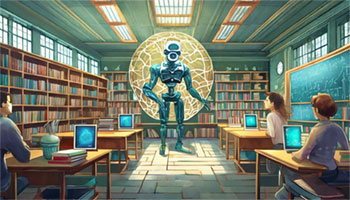A Brave New World of Higher Education

Welcome to 2024. If 2023 ushered in the dawn of the era of AI, then I suspect 2024 will see a deeper embrace of AI as a tool that we start to develop an understanding of how best to use to make our lives easier, make our work more efficient, and to expand our capabilities as educators. In the spirit of full disclosure, I have been using AI to assist in my work for a full year now, and I find it to be an extremely helpful, time-saving tool. It doesnāt do my work for me, but it helps me to be more efficient in doing it. For example, I neglected to write a January 2024 blog post in December, so I needed to crank one out today. Enter AI. I had an idea, āHow faculty can use AI to improve their teachingā and I used Chat GPT to create several possible outlines/drafts of blogs that would cover that topic. Hereās the link to the Chat GPT session Iāve been using to help with some of my . If you look at that chat session, youāll see that this is an iterative process of back and forth with the tool to come to something that I could use as the starting place for an actual blog post. You can also compare the chat session to the final post below for a sense of how I used it as a springboard for my own writing.
Using AI to Update your Teaching

Idea Generation and Inspiration

Exposure to Global Teaching Trends: AI algorithms can scan through a vast array of educational resources, research papers, and teaching methods used worldwide. This helps faculty discover innovative teaching strategies and techniques that are being adopted in different parts of the world, providing a broader perspective and new ideas.
Sample Prompt : What are some innovative ways that strategic communication is being taught that take into consideration various cultural contexts?
Suggesting Customized Teaching Strategies: Based on the specific course content, student demographics, and past course feedback, AI can suggest tailored teaching strategies. For instance, for a course with a high enrollment of visual learners, AI might recommend incorporating more infographics, videos, and interactive visual aids.
Sample Prompt : My students have noted that my graduate course on strategic communication in sports is too lecture-based. How can I make it more student-centered and engaging for them?
Enhancing Interdisciplinary Approaches

Sample Prompt : How can I make my introductory biology class more interdisciplinary. Specifically, I want to include more about climate crisis impacts on biodiversity.
Simulations and Scenario-Based Learning

Sample Prompt : Create a virtual simulation for my class on social stratification in the Roman Empire.
Scenario-Based Learning: AI can generate real-life scenarios for problem-based learning. For instance, in a business class, AI could create market simulation scenarios where students must strategize and make decisions based on changing market conditions.
Sample Prompt : Create a market simulation scenario for my introduction to finance course where students must strategize and make decisions based on changing market conditions.
Personalized Learning Experiences

Sample Prompt : In my course on strategic sports communication outline three different activities to help students understand social media that each appeal to a different type of learner: visual, auditory, and kinesthetic.
Creative Assessment Methods

Sample Prompt : In my course on strategic sports communication outline three ways of assessing studentsā understanding of social media.
Facilitating Collaborative Learning

Sample Prompt : In my course on community health policy suggest three different ways that students can learn collaboratively and how best to assessing studentsā learning in each collaborative activity or project.
By leveraging these and other capabilities of AI, faculty members can not only find new ways to engage their students but also continuously evolve their teaching practices, ensuring they remain dynamic, effective, and enjoyable for both the teacher and the learner.
Authorās note: I kept the AI suggestions as they were generated for the last section but added sample prompts based on the AI example, my own class, or other courses taught here at 91³Ō¹ĻĶų. Iāve included the responses to those prompts below as examples of the work AI can do for you. Each took less than 30 seconds to generate, and while they are not all amazing, I think you will see the utility of the tool for quickly doing much of the basic work, but also to be an inspiration to your own teaching.
- Academics
- Online Programs
- Instructional Design and Delivery IDD




